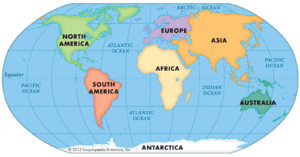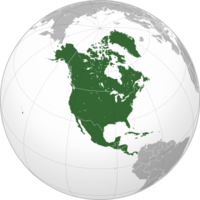North America
| The Seven Continents: Africa • Antarctica • Asia • Australia • Europe • North America • South America |
North America is a continent in the Northern Hemisphere and almost entirely within the Western Hemisphere. It can also be described as the northern subcontinent of a single continent, America. It is bordered to the north by the Arctic Ocean, to the east by the Atlantic Ocean, to the southeast by South America and the Caribbean Sea, and to the west and south by the Pacific Ocean. Because it is on the North American Tectonic Plate, Greenland is included as part of North America geographically.
North America covers an area of about 24,709,000 square kilometers (9,540,000 square miles), about 16.5% of the Earth's land area and about 4.8% of its total surface. North America is the third-largest continent by area, following Asia and Africa, and the fourth by population after Asia, Africa, and Europe. In 2013, its population was estimated at nearly 579 million people in 23 independent states, or about 7.5% of the world's population.
North America was reached by its first human populations during the last glacial period, via crossing the Bering land bridge approximately 40,000 to 17,000 years ago. The so-called Paleo-Indian period is taken to have lasted until about 10,000 years ago (the beginning of the Archaic or Meso-Indian period). The classic stage spans roughly the 6th to 13th centuries. The pre-Columbian era ended in 1492, with the beginning of the transatlantic migrations of European settlers during the Age of Discovery and the early modern period. However, the first recorded European references to North America (other than Greenland) are around 1000 AD in Norse sagas in which it is referred to as Vinland. Present-day cultural and ethnic patterns reflect interactions between European colonists, indigenous peoples, African slaves, immigrants from Europe, Asia, and South Asia, and the descendants of these groups.
Owing to Europe's colonization of the Americas, most North Americans speak European languages such as English, Spanish or French, and their cultures commonly reflect Western traditions. However, in parts of Canada, the United States, Mexico, and Central America, there are indigenous populations continuing their cultural traditions and speaking their own languages.
North America contains the following countries:
- Canada
- United States of America
- Mexico
- plus many smaller countries and islands belonging politically to various other countries.
The Caribbean, too, belongs to North America. The south region of North America is also known as Central America, but this is not a recognized continent of its own. North America and South America are collectively known as the Americas.
Etymology
The continents of North and South America (also sometimes deemed as a single continent, America, especially by many postcolonial Spanish-speaking countries) are thought to be named after the Italian explorer Amerigo Vespucci (who styled himself Americus Vespucius in Latin). Amerigo Vespucci was named after Saint Emeric of Hungary. Vespucci, following his four voyages exploring the coastlines of Venezuela and Brazil, first developed the idea that the newly discovered western land was in fact a continent. The German cartographer Martin Waldseemüller created the earliest known map showing the name America, which he applied to the South American continent only. One later antique map labels the two landmasses "North America or Mexicana" and "South America or Peruana".
Chat rooms • What links here • Copyright info • Contact information • Category:Root

